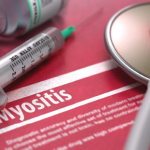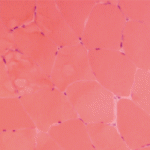All IV immunoglobulin is not the same: Different brand formulations work differently. After two or three months of a patient not responding to IV immunoglobulin, they can typically be considered an official non-responder. But, she said, “In rare cases, you can switch to another [brand] and [the patient will] randomly respond [to treatment].” For a patient who responds initially to a specific brand that becomes ineffective, another brand may increase efficacy.
Exercise is essential: Exercise is anti-inflammatory and fights atrophy. It induces microRNAs that target transcripts and proteins that are important for muscle and immune response. Gene expression and proteomic analysis of skeletal muscle from patients with myositis have identified important changes in exercised muscle. Plus, endurance exercise for more than 12 weeks has beneficial effects on muscle performance and reduced clinical activity.2
“For years, people told myositis patients not to exercise—stay still and [don’t] exacerbate your disease,” Dr. Christopher-Stine said. “This could not be further from the truth. Please tell your patients to do resistance exercise under the direction of a physical therapist.”
Anti-Mi-2 and other so-called myositis specific antibodies may eventually be helpful: This area of research is a work in progress. “There is no standardization of myositis-specific antibodies,” she said. “The great news is they’ve become readily available to many of you in this audience. The bad news is that we don’t have a standardized platform, and there are many false positives and negatives.”
A small clinical trial at Dr. Christopher-Stine’s center concluded that “a positive may not be a positive, and that we may need different level cutoffs for each autoantibody subset.”3
Novel agents remain unproved: Clinical trials are ongoing for the oral endocannabinoid receptor agonist lenabasum and the subcutaneous KZR-616, a selective inhibitor of the immunoproteasome. “We are in an era where novel mechanisms are upon us,” she said. “We have a lot to be excited about, but a lot to wait for.”
Inclusion body myositis: Several agents are being studied for inclusion body myositis, including arimoclomol, which induces heat shock protein 1 and helps with protein misfolding.
Two older drugs that may have new applications in the disease are rapamycin, which restores protein degradation pathways by inhibiting mTOR, and pioglitazone, which increases expression of AMP kinase and PCG-1 alpha. Pioglitazone, a diabetes drug, is thought to result in increased mitochondrial biogenesis in muscle and may improve exercise capacity and mitochondrial function.
New options in this area would be welcome. “Inclusion body myositis has been one of the most challenging subsets of myositis that we see as clinicians,” said Dr. Christopher-Stine.



